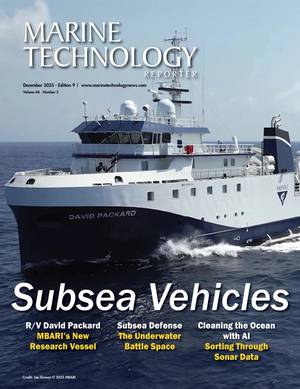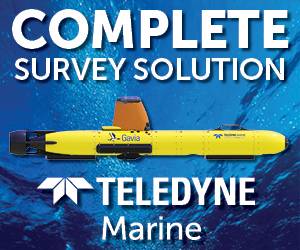Marine Technology Reporter Blogs - temperature
Subsea Instrumentation: CTD Devices

CTD stands for conductivity, temperature, and depth, and refers to a package of electronic instruments that measure these properties. A device called CTD Rosette is lowered into the water and down to the seafloor to measure the salinity, temperature, depth and concentration of particles in the water column. A CTD device’s primary function is to detect how the conductivity and temperature of the water column changes relative to depth. Conductivity is a measure of how well a solution conducts electricity. Conductivity is directly related to salinity, which is the concentration of salt and other inorganic compounds in seawater. Salinity is one of the most basic measurements used by ocean scientists.
Subsea Instrumentation: CTD Devices
CTD stands for conductivity, temperature, and depth, and refers to a package of electronic instruments that measure these properties. A device called CTD Rosette is lowered into the water and down to the seafloor to measure the salinity, temperature, depth and concentration of particles in the water column. A CTD device’s primary function is to detect how the conductivity and temperature of the water column changes relative to depth. Conductivity is a measure of how well a solution conducts electricity. Conductivity is directly related to salinity, which is the concentration of salt and other inorganic compounds in seawater. Salinity is one of the most basic measurements used by ocean scientists.
Subsea Instrumentation: CTD Devices
CTD stands for conductivity, temperature, and depth, and refers to a package of electronic instruments that measure these properties. A device called CTD Rosette is lowered into the water and down to the seafloor to measure the salinity, temperature, depth and concentration of particles in the water column. A CTD device’s primary function is to detect how the conductivity and temperature of the water column changes relative to depth. Conductivity is a measure of how well a solution conducts electricity. Conductivity is directly related to salinity, which is the concentration of salt and other inorganic compounds in seawater. Salinity is one of the most basic measurements used by ocean scientists.
Subsea Instrumentation: CTD Devices
CTD stands for conductivity, temperature, and depth, and refers to a package of electronic instruments that measure these properties. A device called CTD Rosette is lowered into the water and down to the seafloor to measure the salinity, temperature, depth and concentration of particles in the water column. A CTD device’s primary function is to detect how the conductivity and temperature of the water column changes relative to depth. Conductivity is a measure of how well a solution conducts electricity. Conductivity is directly related to salinity, which is the concentration of salt and other inorganic compounds in seawater. Salinity is one of the most basic measurements used by ocean scientists.
Subsea Instrumentation: CTD Devices
CTD stands for conductivity, temperature, and depth, and refers to a package of electronic instruments that measure these properties. A device called CTD Rosette is lowered into the water and down to the seafloor to measure the salinity, temperature, depth and concentration of particles in the water column. A CTD device’s primary function is to detect how the conductivity and temperature of the water column changes relative to depth. Conductivity is a measure of how well a solution conducts electricity. Conductivity is directly related to salinity, which is the concentration of salt and other inorganic compounds in seawater. Salinity is one of the most basic measurements used by ocean scientists.
Subsea Instrumentation: CTD Devices
CTD stands for conductivity, temperature, and depth, and refers to a package of electronic instruments that measure these properties. A device called CTD Rosette is lowered into the water and down to the seafloor to measure the salinity, temperature, depth and concentration of particles in the water column. A CTD device’s primary function is to detect how the conductivity and temperature of the water column changes relative to depth. Conductivity is a measure of how well a solution conducts electricity. Conductivity is directly related to salinity, which is the concentration of salt and other inorganic compounds in seawater. Salinity is one of the most basic measurements used by ocean scientists.
Subsea Instrumentation: CTD Devices
CTD stands for conductivity, temperature, and depth, and refers to a package of electronic instruments that measure these properties. A device called CTD Rosette is lowered into the water and down to the seafloor to measure the salinity, temperature, depth and concentration of particles in the water column. A CTD device’s primary function is to detect how the conductivity and temperature of the water column changes relative to depth. Conductivity is a measure of how well a solution conducts electricity. Conductivity is directly related to salinity, which is the concentration of salt and other inorganic compounds in seawater. Salinity is one of the most basic measurements used by ocean scientists.
Subsea Instrumentation: CTD Devices
CTD stands for conductivity, temperature, and depth, and refers to a package of electronic instruments that measure these properties. A device called CTD Rosette is lowered into the water and down to the seafloor to measure the salinity, temperature, depth and concentration of particles in the water column. A CTD device’s primary function is to detect how the conductivity and temperature of the water column changes relative to depth. Conductivity is a measure of how well a solution conducts electricity. Conductivity is directly related to salinity, which is the concentration of salt and other inorganic compounds in seawater. Salinity is one of the most basic measurements used by ocean scientists.
Subsea Instrumentation: CTD Devices
CTD stands for conductivity, temperature, and depth, and refers to a package of electronic instruments that measure these properties. A device called CTD Rosette is lowered into the water and down to the seafloor to measure the salinity, temperature, depth and concentration of particles in the water column. A CTD device’s primary function is to detect how the conductivity and temperature of the water column changes relative to depth. Conductivity is a measure of how well a solution conducts electricity. Conductivity is directly related to salinity, which is the concentration of salt and other inorganic compounds in seawater. Salinity is one of the most basic measurements used by ocean scientists.
Subsea Instrumentation: CTD Devices
CTD stands for conductivity, temperature, and depth, and refers to a package of electronic instruments that measure these properties. A device called CTD Rosette is lowered into the water and down to the seafloor to measure the salinity, temperature, depth and concentration of particles in the water column. A CTD device’s primary function is to detect how the conductivity and temperature of the water column changes relative to depth. Conductivity is a measure of how well a solution conducts electricity. Conductivity is directly related to salinity, which is the concentration of salt and other inorganic compounds in seawater. Salinity is one of the most basic measurements used by ocean scientists.
Subsea Instrumentation: CTD Devices
CTD stands for conductivity, temperature, and depth, and refers to a package of electronic instruments that measure these properties. A device called CTD Rosette is lowered into the water and down to the seafloor to measure the salinity, temperature, depth and concentration of particles in the water column. A CTD device’s primary function is to detect how the conductivity and temperature of the water column changes relative to depth. Conductivity is a measure of how well a solution conducts electricity. Conductivity is directly related to salinity, which is the concentration of salt and other inorganic compounds in seawater. Salinity is one of the most basic measurements used by ocean scientists.
Subsea Instrumentation: CTD Devices
CTD stands for conductivity, temperature, and depth, and refers to a package of electronic instruments that measure these properties. A device called CTD Rosette is lowered into the water and down to the seafloor to measure the salinity, temperature, depth and concentration of particles in the water column. A CTD device’s primary function is to detect how the conductivity and temperature of the water column changes relative to depth. Conductivity is a measure of how well a solution conducts electricity. Conductivity is directly related to salinity, which is the concentration of salt and other inorganic compounds in seawater. Salinity is one of the most basic measurements used by ocean scientists.
Subsea Instrumentation: CTD Devices
CTD stands for conductivity, temperature, and depth, and refers to a package of electronic instruments that measure these properties. A device called CTD Rosette is lowered into the water and down to the seafloor to measure the salinity, temperature, depth and concentration of particles in the water column. A CTD device’s primary function is to detect how the conductivity and temperature of the water column changes relative to depth. Conductivity is a measure of how well a solution conducts electricity. Conductivity is directly related to salinity, which is the concentration of salt and other inorganic compounds in seawater. Salinity is one of the most basic measurements used by ocean scientists.
Subsea Instrumentation: CTD Devices
CTD stands for conductivity, temperature, and depth, and refers to a package of electronic instruments that measure these properties. A device called CTD Rosette is lowered into the water and down to the seafloor to measure the salinity, temperature, depth and concentration of particles in the water column. A CTD device’s primary function is to detect how the conductivity and temperature of the water column changes relative to depth. Conductivity is a measure of how well a solution conducts electricity. Conductivity is directly related to salinity, which is the concentration of salt and other inorganic compounds in seawater. Salinity is one of the most basic measurements used by ocean scientists.
Subsea Instrumentation: CTD Devices
CTD stands for conductivity, temperature, and depth, and refers to a package of electronic instruments that measure these properties. A device called CTD Rosette is lowered into the water and down to the seafloor to measure the salinity, temperature, depth and concentration of particles in the water column. A CTD device’s primary function is to detect how the conductivity and temperature of the water column changes relative to depth. Conductivity is a measure of how well a solution conducts electricity. Conductivity is directly related to salinity, which is the concentration of salt and other inorganic compounds in seawater. Salinity is one of the most basic measurements used by ocean scientists.
Subsea Instrumentation: CTD Devices
CTD stands for conductivity, temperature, and depth, and refers to a package of electronic instruments that measure these properties. A device called CTD Rosette is lowered into the water and down to the seafloor to measure the salinity, temperature, depth and concentration of particles in the water column. A CTD device’s primary function is to detect how the conductivity and temperature of the water column changes relative to depth. Conductivity is a measure of how well a solution conducts electricity. Conductivity is directly related to salinity, which is the concentration of salt and other inorganic compounds in seawater. Salinity is one of the most basic measurements used by ocean scientists.
Subsea Instrumentation: CTD Devices
CTD stands for conductivity, temperature, and depth, and refers to a package of electronic instruments that measure these properties. A device called CTD Rosette is lowered into the water and down to the seafloor to measure the salinity, temperature, depth and concentration of particles in the water column. A CTD device’s primary function is to detect how the conductivity and temperature of the water column changes relative to depth. Conductivity is a measure of how well a solution conducts electricity. Conductivity is directly related to salinity, which is the concentration of salt and other inorganic compounds in seawater. Salinity is one of the most basic measurements used by ocean scientists.
Subsea Instrumentation: CTD Devices
CTD stands for conductivity, temperature, and depth, and refers to a package of electronic instruments that measure these properties. A device called CTD Rosette is lowered into the water and down to the seafloor to measure the salinity, temperature, depth and concentration of particles in the water column. A CTD device’s primary function is to detect how the conductivity and temperature of the water column changes relative to depth. Conductivity is a measure of how well a solution conducts electricity. Conductivity is directly related to salinity, which is the concentration of salt and other inorganic compounds in seawater. Salinity is one of the most basic measurements used by ocean scientists.
Subsea Instrumentation: CTD Devices
CTD stands for conductivity, temperature, and depth, and refers to a package of electronic instruments that measure these properties. A device called CTD Rosette is lowered into the water and down to the seafloor to measure the salinity, temperature, depth and concentration of particles in the water column. A CTD device’s primary function is to detect how the conductivity and temperature of the water column changes relative to depth. Conductivity is a measure of how well a solution conducts electricity. Conductivity is directly related to salinity, which is the concentration of salt and other inorganic compounds in seawater. Salinity is one of the most basic measurements used by ocean scientists.
Subsea Instrumentation: CTD Devices
CTD stands for conductivity, temperature, and depth, and refers to a package of electronic instruments that measure these properties. A device called CTD Rosette is lowered into the water and down to the seafloor to measure the salinity, temperature, depth and concentration of particles in the water column. A CTD device’s primary function is to detect how the conductivity and temperature of the water column changes relative to depth. Conductivity is a measure of how well a solution conducts electricity. Conductivity is directly related to salinity, which is the concentration of salt and other inorganic compounds in seawater. Salinity is one of the most basic measurements used by ocean scientists.

 December 2025
December 2025



